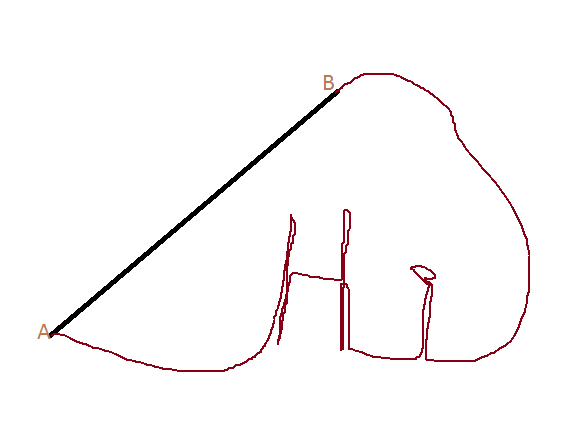I'm new to physics, and I just learned what velocity is. From what I learned, velocity is, displacement/time. But, I'm confused about what displacement and distance is, and how is affects velocity. So, if displacement is how far you are from your original position, then you would have a displacement of 0m if you ran 500m and back in 10 seconds, and stopped in the same position. The distance, however, would be 1km, I'm guessing. Now, if I use displacement in my formula, then I would have a velocity of 0 m/s. But, if I used the distance, it would be 50 m/s. So, which would I use?
-
$\begingroup$ When you ran away from your starting point, you had positive velocity (and speed, which is always positive), but when you ran back you had negative velocity (because you changed direction) - so the average can be $0$, but speed is positive always so you will have a net average speed that is larger than $0$. $\endgroup$– Ofek GillonCommented Mar 8, 2017 at 5:45
2 Answers
You are right regarding the meaning of displacement and distance. Displacement denotes how far (in direct line) you are from the origin. Distance is the length covered.
As for velocity you need to distinguish between instantaneous velocity and average velocity.
Instantaenous velocity
The instantaneous velocity is defined as the time derivative:
$$\mathbf{v}(t)=\lim_{\Delta t\to 0} \frac{\Delta (\mathrm{displacement})}{\Delta t} = \frac{d (\mathrm{displacement})}{d t}$$
Note that this velocity is a vector describing how fast (=speed) and in what direction you are moving at any moment in time (therefore the time dependence). $\Delta (\mathrm{displacement})$ is the displacement and is also a vector, going from a point along the path reached at time $t$ to a point reached at a later time, $t+\Delta t$ as in the image above.
As you can see from the image, if you look at the displacement after a very short time (i.e. you take the limit $\Delta t\to 0$), the displacement vector (and the instantaneous velocity) will in fact be along the track.
Generally, if physicists talk about "velocity" this instantaneous velocity (vector) is meant.
Instantaneous speed
Speed is the magnitude (how fast?) of the velocity vector
$$s(t)=|\mathbf{v}|$$
This is the quantity displayed on your car's speedometer and it does not contain any information about the direction.
Average velocity
The average velocity is defined as:
$$\bar{\mathbf{v}}= \frac{\Delta (\mathrm{displacement})}{\Delta t}$$
This is essentially the same definition as for the instantaneous velocity without taking the limit. Like the instantaneous velocity, the average velocity is a vector quantity. As you can see from the definition if you return to your starting point you have (over that time interval) an average velocity of 0.
Equivalently the average velocity can be expressed as average/integral over the instantaneous velocities: $$\bar{\mathbf{v}}=\frac{1}{\Delta t}\int_0^{\Delta t} \mathbf{v}(t)~dt$$
If you return to the origin during the time period $\Delta t$, the integral on the right side will evaluate to zero because the directions of the instantaneous velocities will average out: essentially in order to return you have to reverse the velocity at some point.
Average speed
The average speed is the total distance divided by the time taken:
$$\bar{s}=\frac{\Delta (\mathrm{distance})}{\Delta t}$$
or equivalently:
$$\bar{s}=\frac{1}{\Delta t}\int_0^{\Delta t} s~dt$$
If you return to the origin, the average speed is not zero because here the distance (and not the displacement) enters the equation.
Because the distance is always at least as big as the length of the displacement ($\Delta (\mathrm{distance})\geq |\Delta (\mathrm{displacement})|$), the average speed is always at least as big as the magnitude of the average velocity ($\bar{s}\geq |\bar{\mathbf{v}}|$).
So, which would I use?
Example
This depends on the situation and what you want to describe. Let's take as an example the popular riddle where a snail falls into a very deep well and is trying to get out climbing up. During the day (12 h) the snail is climbing up 30 cm. At night (12 h) the snail is sliding down 10 cm.
If you want to discuss how much progress the snail is making towards the top, it would make sense to talk about the average velocity (20 cm / 24 h). If on the other hand you want to discuss the climbing capabilities you would rather discuss the instantaneous velocity (30 cm / 12 h).
You must think displacement as the shortest distance between two points. Distance is the actual distance you travel while going between two points.
In the above example, the length of the black line gives the displacement between the two points $A$ and $B$ and the length of the brown line between the two points $A$ and $B$ gives the distance traveled.
By definition, velocity is given by:
$$\vec{v} = \frac{\Delta(displacement)}{\Delta t} = \frac{d(displacement)}{dt}$$
By definition, speed is given by:
$$s = \frac{\Delta distance}{\Delta time}$$
In your case, you return to the same point, therefore, you have a net displacement of zero but the net distance traveled is not zero.
As the net displacement is zero, your net velocity is also zero. As your net distance is not zero, your average speed is not zero.
Useful references:
distance and displacement of an object on a straight line
What is displacement? Position relative to a reference point or change of position


